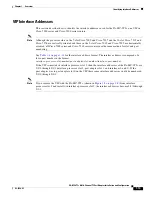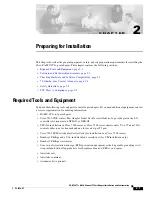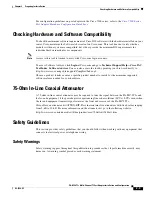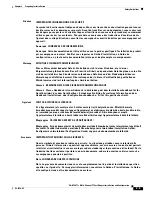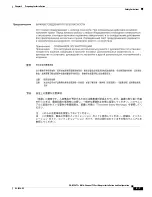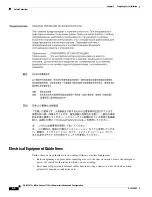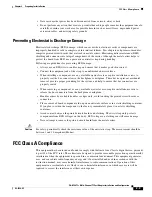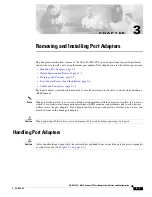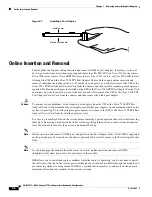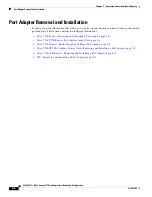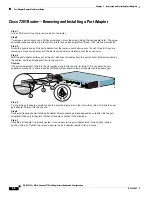
3-3
PA-MC-2T3+ Multi-Channel T3 Port Adapter Installation and Configuration
OL-3526-05
Chapter 3 Removing and Installing Port Adapters
Warnings and Cautions
The following is a functional description of OIR for background information only; for specific
procedures for installing and replacing a module in a supported platform, refer to the
Removal and Installation” section on page 3-4
.
Each module has a bus connector that connects it to the router. The connector has a set of tiered pins in
three lengths that send specific signals to the system as they make contact with the module. The system
assesses the signals it receives and the order in which it receives them to determine if a module is being
removed from or introduced to the system. From these signals, the system determines whether to
reinitialize a new interface or to shut down a disconnected interface.
Specifically, when you insert a module, the longest pins make contact with the module first, and the
shortest pins make contact last. The system recognizes the signals and the sequence in which it receives
them.
When you remove or insert a module, the pins send signals to notify the system of changes. The router
then performs the following procedure:
1.
Rapidly scans the system for configuration changes.
2.
Initializes newly inserted port adapters or administratively shuts down any vacant interfaces.
3.
Brings all previously configured interfaces on the module back to their previously installed state.
Any newly inserted interface is put in the administratively shutdown state, as if it was present (but
not configured) at boot time. If a similar module type is reinserted into a slot, its ports are configured
and brought online up to the port count of the originally installed module of that type.
Note
Before you begin installation, read
Chapter 2, “Preparing for Installation,”
for a list of parts and tools
required for installation.
Warnings and Cautions
Observe the following warnings and cautions when installing or removing port adapters.
Note
If a port adapter lever or other retaining mechanism does not move to the locked position, the port
adapter is not completely seated in the midplane. Carefully pull the port adapter halfway out of the slot,
reinsert it, and move the port adapter lever or other mechanism to the locked position.
Caution
To prevent jamming the carrier between the upper and the lower edges of the port adapter slot, and to
ensure that the edge connector at the rear of the port adapter mates with the connection at the rear of the
port adapter slot, make certain that the carrier is positioned correctly, as shown in the cutaway in the
following illustrations.
Caution
When performing the following procedures, wear a grounding wrist strap to avoid ESD damage to the
card. Some platforms have an ESD connector for attaching the wrist strap.
Warning
Hazardous voltage or energy is present on the backplane when the system is operating. Use caution
when servicing.

